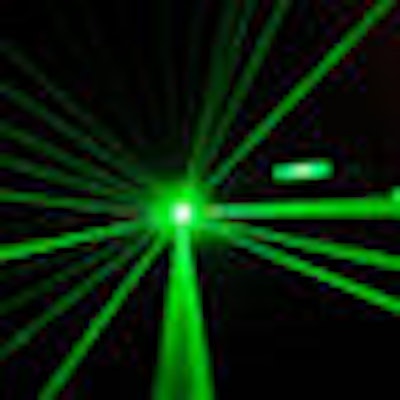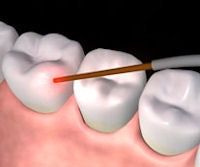
As the first periodontist in the U.S. to practice laser-assisted new attachment procedure (LANAP) in his practice, Lloyd Tilt, D.D.S., M.S., has carefully tracked his patients' experiences over the past decade -- and been delighted with his findings.
"Lasers are a wonderful option for doctors and patients to consider in treating periodontal disease," Dr. Tilt said at the American Academy of Periodontology (AAP) annual meeting in Boston last month.
But just five days before Dr. Tilt delivered his lecture, complete with new statistics showing the advantages of laser treatments over traditional techniques, the AAP endorsed the ADA's cautionary policy on laser use. The ADA's Council on Scientific Affairs warned in its policy, released last April, that it was still too early to know "to what extent LANAP [laser-assisted new attachment procedure] is safe and effective across the spectrum of patients with chronic periodontitis."
The policy was another blow to Millennium Dental Technologies, which invented the LANAP procedure and began selling its PerioLase laser in 1999 for removing dental caries as well as diseased tissue in periodontal pockets. In its policy statement, the ADA dismissed the laser curettage procedure for periodontal pockets as having "no known clinical value."
But the criticism didn't deter Dr. Tilt, a Utah periodontist and instructor for Millennium's Institute for Advanced Laser Dentistry.
Speaking at the AAP meeting, he told a crowded room of periodontists that the ADA should "take another look" at the laser research. He presented data on 107 patients he'd followed over the past 10 years, comparing his results to three other periodontal studies. Only 46 of the 2,696 teeth he treated with lasers were lost to periodontitis, he said. That's just 1.7% teeth lost for patients followed for 6.2 years, on average.
By contrast, in the three studies examining patients treated with more traditional methods, 9.8% of teeth were lost in one study and approximately 5% of teeth were lost in the other two. The authors of these studies, however, followed patients much longer than Dr. Tilt did. The studies showing 5% tooth loss followed patients for 12.5 years and 13.6 years, while the one showing 9.8% tooth loss followed patients for 19 years.
Dr. Tilt also said that only 4.7% of his patients were going downhill after six years, compared to the longer studies where 14.3%, 15.8%, and 23% of patients were. Even though the other studies were longer, he said, their duration could not account for the poorer performance results.
Not only do patients get better results with LANAP, he said, but they are more likely to accept the laser treatment. With lasers, he said, there is no postoperative swelling or bleeding, no additional gingival recession, and no extra tooth sensitivity.
Dr. Tilt stressed the necessity of treating all his patients' teeth. "It's important to disinfect the entire mouth," he said, pointing out the laser's capacity to reduce infections. In the studies of more conventional methods, dentists did not treat each tooth.
Effectiveness questioned
In spite of such testimonials, though, few periodontists use lasers in their practices. Dr. Tilt estimates that fewer than 8% of his colleagues use them.
 |
| With LANAP, the laser fiber is inserted between the periodontal tissue and tooth to selectively remove diseased or infected pocket epithelium from the underlying connective tissue. Image courtesy of Millennium Dental. |
"There isn't a huge amount of research," said Meg Dempsey, an AAP spokeswoman. "There isn't anything conclusive."
Indeed, there are few studies on laser use for periodontal work, and they have generated vigorous debate. Even online forums are filled with heated discussions. A recent post about LANAP on a dentistry online forum generated 63 responses, with dentists analyzing the latest research studies and spinning conspiracy theories.
"The AAP is terrified of GP's with lasers," John G. McAllister, a California dentist, wrote on the OsseoNews forum. "And the AAP has every reason to be afraid of GP's having an effective tool for treating moderate to severe gum disease."
For its part, Millennium continues to cite the work of Raymond Yukna, D.M.D., M.S., director of advanced periodontal therapeutics at the University of Colorado, Denver School of Dental Medicine. In a 2007 study published in the International Journal of Periodontics and Restorative Dentistry (Vol. 27:6, pp. 577-587), Dr. Yukna reported his examination of a dozen teeth, half of which had been treated with the LANAP procedure. All six of the LANAP-treated teeth showed new cementum and new connective tissue attachment, whereas five of the six teeth in the control group showed no such attachments, he found.
The ADA position paper said the study "provides no more than pilot validation for this treatment concept." The small sample size and the condition of the diseased teeth make it difficult to extrapolate the results to the general population, it said.
Millennium vigorously opposed the ADA's analysis, calling it "inaccurate, misleading, and scientifically unsubstantiated."
"It is terribly unfortunate that ... the use of lasers for the purposes of treating periodontal disease, and the research that supports it, continues to be marginalized," wrote Delwin McCarthy, D.D.S., chief technology officer of Millennium, in a formal rebuttal to the ADA policy.
Millennium argues that Dr. Yukna's study was not small, given what it was examining. It is the fourth largest human histology study in the periodontal scientific literature, it said, pointing out that institutional review boards strictly limit the size of such studies.
History of skepticism
Using lasers for periodontal treatment has met with skepticism for years. Douglas Dederich, D.D.S., Ph.D., former vice-chair of the ADA's Council on Scientific Affairs and former chair of an ADA committee outlining laser standards, has repeatedly voiced uneasiness with laser procedures.
In 2000, he wrote the U.S. FDA that there was "significant concern" in the dental community that applying the laser in the gingival sulcus "represents a serious risk to the dental pulp." The damage may not be detectable by standard pulpal tests, he wrote, but research with animal tissue examined under a microscope had shown severe pulpal damage. If such damage were to occur in humans, it would require root canal therapy.
Later, in a 2004 article in the Journal of the American Dental Association titled "Lasers in dentistry: Separating science from hype" (Vol. 135:2, pp. 204-212), he and co-author Ronald Bushick, D.M.D., Ph.D., wrote that laser curettage "appears to be neither scientifically nor ethically justified." They did say, however, that early evidence shows "exciting potential" for lasers to produce superior attachment levels after root debridement compared to mechanical planing.
Dr. Dederich could not be reached for comment as to whether he thinks that potential is now any closer to reality. And the AAP declined to comment beyond its formal endorsement of the ADA policy.
So, for now, the controversy continues, with dentists relying on their own judgment, experience, and existing research to figure out what is best for their patients.
Copyright © 2009 DrBicuspid.com



















